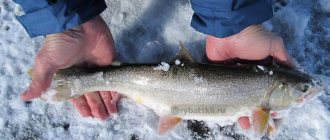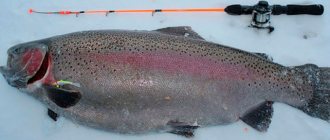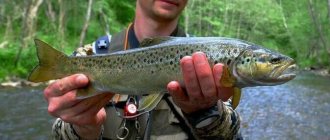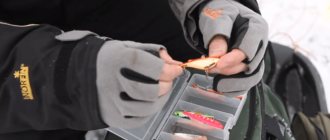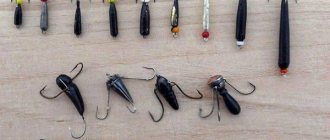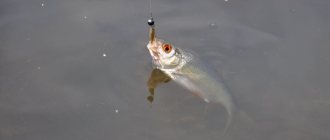Trout is the common name for species of salmon fish. It has great commercial value; many fishermen are fond of fishing it. It is considered a noble fish and is valued in cooking. Its meat contains vitamins and microelements. It is fried, smoked, salted, and taken raw.
Trout is divided into many subspecies and forms. Depending on living conditions, time and place of reproduction, and feeding period, the appearance of these fish changes, acquiring the features of one or another subspecies or form. The phenotype (appearance) of salmon fish is variable.
There is no consensus among ichthyologists about whether any form belongs to a specific species or even genus. The exception is species that have long lived in the same rivers or lakes. Recently, due to the introduction, relocation and acclimatization of new species, changes in habitual living conditions, many new forms and variants have formed among well-established species.
Three species are of greatest interest to amateur fishermen: lake trout, brook trout, and a newcomer from distant America—rainbow trout.
All species have a similar body shape. Slightly stretched, compressed from the sides. Males are small in size and have more teeth. Trout have small, dense scales. Two dorsal fins - main and adipose. The color depends on its location. When the day is light, the fish is silvery with black spots. On a dark bottom it is darker. Brook trout is brown in color and its head may be black. Black and red spots are randomly located throughout the body. She is called the pestrushka.
The color of the fish changes during the mating season. The body is dark, covered with orange stripes with bright spots. The pelvic fins turn orange.
Trout is a predatory fish and its diet consists of small fish, insects, and mollusks living near the surface of the water. Feeding occurs throughout the year, even during the spawning period.
Where and when do you catch trout using lures?
Possessing high gastronomic qualities, trout attracts the attention of many anglers. She does not like temperatures above 20 degrees. Found in cool rivers and ponds. Early spring is considered a good time for fishing. This predator is very careful; spinning fishing with spinners gives greater effect.
Spinner is an artificial bait that comes in many varieties. You can throw it anywhere. For example, where it is impossible to deliver live bait.
It is used when fishing for predatory fish. Pike, perch, pike perch, asp, trout - this is not a complete list of underwater inhabitants that fall for this bait.
You can fish for trout all year round. This fish loves cool and clean water. On a hot day, it goes into the depths, and with sunset it comes back to the surface. Therefore, it is better to catch it in the evening and all night.
In spring, this species is caught in the late afternoon, and in autumn it bites all day long. It is especially active during the flight of the mayfly. This is the end of May and the beginning of June.
Habitats: mountain rivers and large lakes. The fish is very shy; complete silence is needed for successful fishing. When going fishing, wear camouflage clothing to be invisible against the background of nature. Trout are positioned against the current, in fast water. Approach the fish site carefully, otherwise the school will move to another place.
In winter, trout bite on different spoons, it all depends on the reservoir. Winter spinners with golden and copper colors are more suitable.
Seasonal features of choosing trout spinners
Trout are very careful. This circumstance makes fishing exciting. An interesting tackle for trout is spinning. It is important to choose the best lure to catch these fish. Classification of spinners is very difficult. They are divided into winter and summer, perch and pike. There is a big difference between winter and summer ones: summer ones move horizontally in the water, and winter ones move vertically.
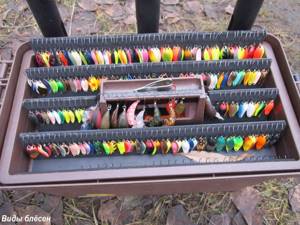
Summer types of spinners:
Oscillating (oscillators) - a curved metal plate in the shape of a fish. On one side it is attached to the fishing line through a ring, and on the other it is equipped with a tee. Moving in the water, it makes rhythmic oscillatory movements, which attracts fish.
- Rotating spoons (spinners) are complex and thin structures. A petal plate and special beads are placed on a wire rod. A tee is attached to the end of the rod. By stretching such gear in the water, the angler creates vibrations and noise, which also attracts fish.
- Acoustic spinners, when retrieved, produce sounds that are audible to fish. To do this, ordinary metal balls are built into it. Winter types of spinners:
- Diving ones look like small fish on metal plates. Weights are soldered onto them to imitate the movement of a fish. Such spoons are used when fishing from ice.
- Horizontally submersible - metal spoons with a fishing line attached in the middle. When thrown into the water they move in a circle.
Fishing with horizontal spoons is learned in advance. A good effect is achieved when catching burbot, which grabs the prey across. In this case, a horizontal spoon guarantees a hook.
Winter
Trout are caught using spoons when the ice becomes strong and you can go out on it without fear. The fish is constantly moving around the pond, so it’s impossible to sit in one place. If there is no bite for 10-15 minutes, then move to another place. Greater activity is observed at sunrise; during the day the bite weakens.
There are paid reservoirs filled with fish. No one returns without a catch, but there is no excitement, like on a natural body of water.
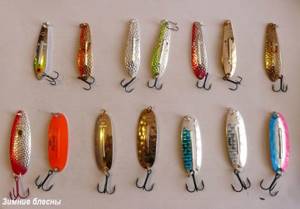
The fish are biting on different lures. The most catchy ones for trout fishing in winter:
- Daiwa Silver Creek;
- Smith Pure;
- Rublex Celta turbo;
- Lukris Pulpos Luky;
- Mepps Black Fury.
For winter trout fishing from ice, you must remain quiet, do not scare them away, and do not knock on the ice. Start drilling holes from the shore to the center of the lake. Having found a difference in depth, stop and start flashing.
If the place is unfamiliar, then, if possible, ask local fishermen about the reservoir. Take a simple fishing rod for trolling. To prevent the fish from pulling all the gear into the hole, tie a light strip with a diameter larger than the hole perpendicular to the whip.
The jig is suitable for any color and shape, but the hook must be sharp. The technique of the game involves falling and raising the jig with stops. When there is a bite, the wiring should be energetic, and when the bite is rare, it should be slow.
Spring
Trout lives where there are no other fish. Therefore, when planning to catch it, tune in only to this type of fish.
For fishing, a rigid spinning rod up to 3.5 meters long is used. The reel is taken with high speed, line with a diameter of 0.25-0.30 millimeters. It is better to use a thinner line, this will make it easier to guide the bait, which is important for trout.
There are two methods of guiding trout spoons - with a descent in a circle and with a release downstream, in a straight line.
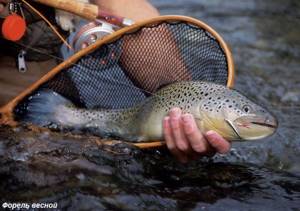
The first method is used when fishing is done from the shore or a coastal ledge. Throwing the tackle upstream and allowing the bait to sink to the bottom, the tackle is raised. Under the force of the current, the bait moves in a wide arc, moving from the bottom to the surface.
In a situation where it is necessary for it to sink to the bottom when approaching the shore, the fishing line is pulled up immediately after touching the water or a few seconds earlier. By changing the speed of the retrieve, the fishing depth also changes. This method is very good for checking large boulders located in the riverbed, or slopes and edges placed in front of the angler of pools and holes.
In the second case, using the force of the current, the bait is thrown forward along the riverbed for some distance, and then, reeling in a fishing line, the bait is pulled against the current. By turning the rod, the bait is delivered to where the fish may be.
By increasing the speed of the spinner, it is lifted to the upper layers of the water, and by decreasing it, it is lowered to the bottom. The best way to catch trout is with bait that is found in this reservoir. This could be caddisfly or other insect larvae, which can be easily collected in the river or on the shore.
Autumn
Autumn is different from other trout fishing seasons. Cool nights begin, the fish become aggressive, fattening up before winter. At this moment, large specimens may be caught.
Daytime is good for fishing. Trout can be found near riffles with stones, in holes. You won’t find it in a shallow place anymore.
The choice of gear when fishing determines its success. For float fishing, choose a longer rod; for shy fish, long casts are made.
The most catchy lures for trout in the fall are “spinners.” They are cheap and effective. Size is not important; even a small bait can be taken by a large specimen.
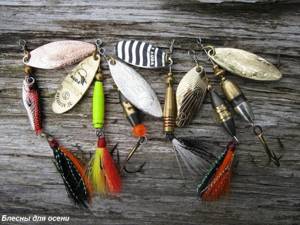
Suitable colors are silver and purple. Red and yellow baits confuse the fish, reminding them of fallen leaves. “Spreaders” are also successful when fishing for trout.
In autumn, this fish no longer stands at the surface of the water. Therefore, the selected baits must be deep-sea.
Winter trout trolling
When using winter lures for trout on a platform, you need to use the same ones as on natural bodies of water. The fishing tactics are the same - searching for the place and water horizon along which the fish is walking. It’s simply easier to do this on a paid site, since the water area is limited, and therefore it is known for certain that the spotted predator is somewhere here. However, if you do it ineptly, you won’t be able to catch it even on a paid lake. This fish requires a special approach.
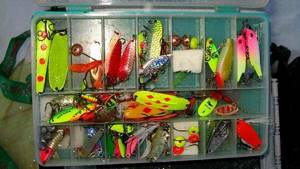
Search tactics
Usually trout stand at night in their favorite places - holes, drop-offs and edges, underwater drops. With the first rays of the sun, the fish become more active and begin to feed intensively near the place where they spend the night. This period can last only about twenty minutes. Then the predator goes on patrol. Its paths are not constant, like those of burbot. The fish changes them constantly. In addition, even the horizon of the water where the flock makes its raids is constantly changing. All daylight hours it plows the pond, and the fisherman’s task is to predict where the spotted fish will be in the next moment and drill holes there. Trout are not particularly intelligent, but under ice they can be cautious, which makes up for their lack of intelligence. You can’t make noise or stomp on the ice; everything is done quietly and quickly.
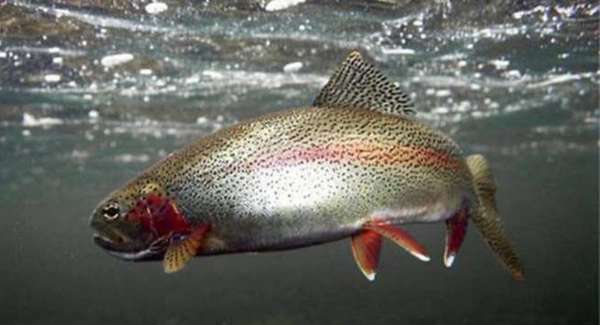
If the fish has recently been released (or is done periodically a little at a time especially for the arrival of fishermen), then it wanders chaotically around the reservoir and grabs everything in sight, exploring the new space. After some time, the school calms down and appears more often not throughout the entire water area, but in its favorite places. It is better to find out all these nuances in advance from the administration of the paysite or other reservoirs, since fishing tactics depend on the answers.
If the launch was a long time ago, and the trout “settled”, then you need to identify places where they spend the night, near which you should start fishing early in the morning, then moving on to other areas in order to find moving fish. If the launch was recent, then it is more important to determine the desired fishing horizon and fish it with various spoons in order to find a working bait. The iris very rarely walks near the bottom, usually in half the water. During a thaw, it can generally rise to the upper edge and wander just under the ice shell. You need to check all horizons and promising places - holes, depressions, areas near aerators. Moreover, fishing must begin from the upper layers. The standard winter technique for trout for any lure is to play for a fall.
Fishing rod rig
A fishing rod for trolling winter trout needs to be rigid enough to make hooking easy. The whip must be equipped with a nod. During periods of passivity, trout can simply butt the spoon and grab it - you won’t see such bites without a guard. The hook needs to be short and sharp - the spotted one does not clamp the jaws too tightly when grasping, you should not rely on a self-hook.
Some fishermen use long fishing rods, up to a meter, equipped with spinning reels. This type of gear is convenient for catching fish, but working actively with a spoon all day long is difficult. Experienced fishermen choose short elastic fishing rods, no more than 30-45 cm, equipped with inertial wire reels. Part of the spinner game is lowering the bait, so quite often you have to work with your arm fully extended upward. And it’s inconvenient to work with a big heavy fishing rod all the time. Article about fishing rods for winter trout
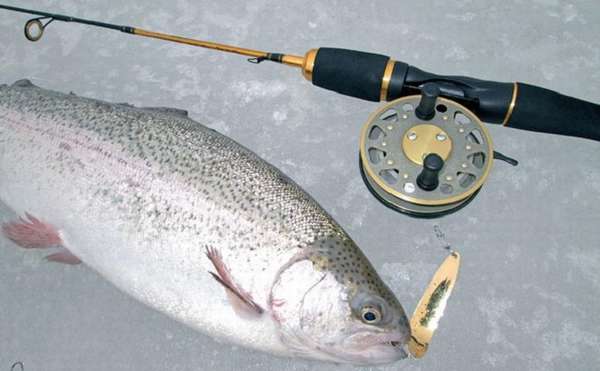
Tackle for trout fishing with lures in winter must be equipped with high-quality winter fishing line, with low elongation and without memory. Diameter – about 2-0.35 mm. The most commonly used winter fluorocarbon is 0.25-0.27 mm. This thickness of fluor is sufficient for landing large trout. A monofilament that is too stretchy will result in empty hooks. Trout, of course, is not a pike perch, however, in order to cut through the mouth of a trout, you need to have time to make a short, sharp hook. This is the main problem for beginners - the trout grabs the spoon for a split second and immediately spits it out; when it bites, you need to hook it immediately, otherwise the fish will get away. A soft, stretchable line will not allow you to make a correct hook. A metal leash is not required (if there is no pike pirates in the pond) - the spoon clings directly to the main fishing line using any knot - clinch, palomar, in a loop on a figure eight, etc. If you plan to change spinners frequently, then it is better to hook the bait through a carabiner.
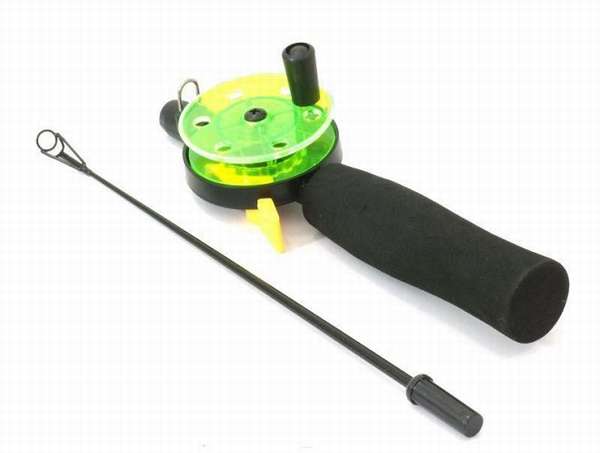
Working spinners
Winter lures for trout in paid ponds and lakes are used the same as for catching wild predators. Platnik is a great place to test baits. If you simply cannot find this fish in a natural lake, then in paid reservoirs it certainly is, and catching a spotted one is a matter of tactics and technique. The best trout winter lures are elongated small spoons that resemble fish fry. Colors – silver, copper and multi-colored. Often the spotted one attacks bright pink or orange (carrot) colors. Various painted eyes, stripes and other stimuli can work great, especially in clear water. The iris does not always attack the spinner for food. Often the reason for an attack is aggression, an attempt to remove a competitor from the territory.
Good winter lures for trout have a gliding action; usually the center of gravity of such baits is shifted slightly forward, and they widen towards the bottom. Optimal sizes are 4-8 cm, no more. You need to strive to find one or two catchy spinners according to their shape in several colors.
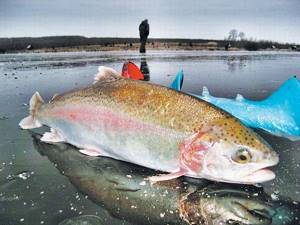
Williams Wabler and others
The most popular and main spinner for catching trout in winter on plateaus is the Williams Wobbler W30 or W40. A thirty wobbler weighs 4 grams, a forty wobbler weighs 7 g. These two sizes are enough for trout. You need to experiment with colors, of which there are dozens. For trout - silver, copper, painted pink, orange, etc. Williams Ice Jig silver with red stickers also works well on spotted fish. It is better to immediately remove the additional hook in the middle. These spinners play consistently and correctly - this is the main advantage. There is no need to reinvent the wheel here - these lures work, and well. However, winter Williams spinners for trout are quite expensive. Cheap analogues can be found among Chinese replicas, but they do not have exactly the same bending, balancing and play. These Williams spinners for winter trout fishing are a long-established and proven classic, like the Atom 2 for pike.

Naturally, this is not the only solution. The range of baits also includes other spoons that perform well when fishing for trout from ice:
- Daiwa Skinny Spoon.
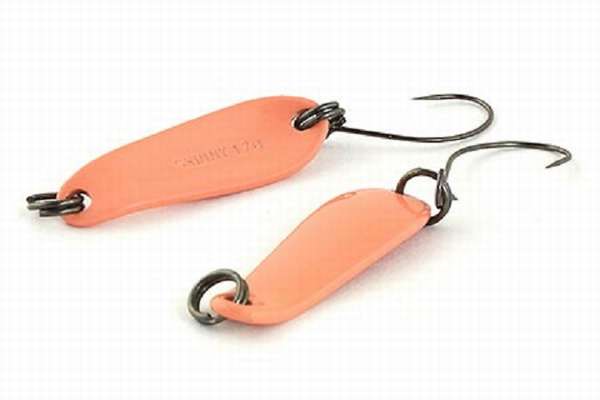
- Forest Miu Native 28.

- Smith Pure.

- Bassday Kangoku Raptor.

- Skagit Designs Pri Spoon.
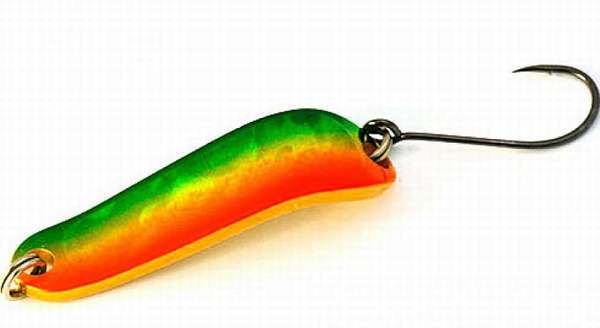
In addition to spoons, trout readily respond to cicadas (bladebaits) and winter wobblers - ratlins. Fishing with such baits requires a completely different game; the equipment can be used the same as for spinners. Read more about fishing for trout in winter with rattlins.
After purchasing, you need to remove the single hooks from the spinners and replace them with high-quality tees (for example, Owner). This modification will reduce the number of idle hookups significantly. You can attach holographic stickers or eyes to single-color lures - this is only a plus for trout. The spotted predator responds well to tee decorations - red threads, beads, feathers. The main thing is not to overdo it with decoration, so as not to disrupt the play of the spinner. A good solution is ready-made tees with drops.
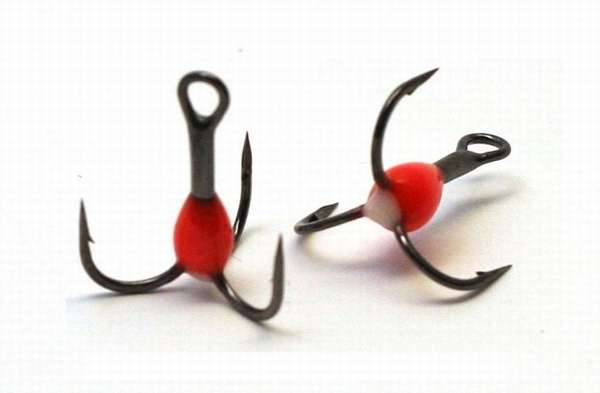
What kind of spoons are used for trout fishing?
The choice of spinners depends on the fishing location:
- You can search for brook trout on a spinning rod throughout the year. Here the spoon must work steadily in the current.
- Lake or pond trout are caught using small baits. Here the fish have enough food; spinning fishing continues until the ice freezes completely.
Rotating spoons for trout:
- Mepps turntables - the petal works stably at slow retrieves. The Aglia series are popular.
- Wordens Rooster Tails. They have special plumage like a fly.
- Flash spinners from Blue Fox have a heavy core, which allows you to catch larger fish.
- The Myran Akka spinner is designed for currents and creates a lot of noise in the water.
Suitable spinners for trout:
- Daiwa Presso Rave spinner. Suitable for fishing in shallow water, weight up to 2.5 grams, has a low oscillation frequency.
- A series of PriSpoon spinners from Skagit Designs. Works in fast currents, loaded to the full depth.
- The Bassday Kangoku Raptor spinner has good long-casting characteristics and stable play.
- The Forest Miu Native spinner represents a classic lure for trout fishing. Very similar to a fry.
What criteria are used to select a lure for trout fishing?
Spoons for trout fishing are the main criterion for successful fishing. The choice of bait is also made according to the seasons:
- In spring, trout are less careful; they begin to feed after winter. The fisherman manages to get close to the fish. They are caught using baits similar to fry and insects. The wiring goes under the surface of the water;
- At the beginning of summer, trout feed a lot; they are found throughout the entire depth. A good time is early morning, the bait is cast quickly.
Spinner spoons of the “spinning” type work well in different waters and have excellent flight qualities.
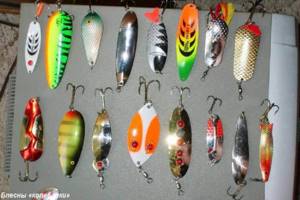
When choosing them, pay attention to the following features:
- selection by size - fish weight 700 grams - bait length up to 5 cm, fish weight 1 kilogram - bait length up to 8 cm;
- The weight of the spoon depends on the speed of the current and the required casting distance.
In medium currents it is advisable to have a bait weighing up to 5 grams, and in still water you can use micro-oscillators;
- The color of the bait should be varied; red and pink shades are suitable for trout.
When choosing a spoon, consider the depth of the reservoir. In shallow water the bait should be light. Some anglers use a spinner with a thick core. This bait has a stable game.
Pay attention to the size of the reservoir; not every bait can be cast far.
The best lures for trout:
- Forest Miu Native 2.8;
- Daiwa Skinny Spoon 1,2;
- Williams Wabler W30;
- Mepps Black Fury No. 2;
- Daiwa Silver Creek Spinner R;
Necessary materials and tools for making vibrators
When you get the required quantity of workpieces, look for a hacksaw, a drill with metal drills, a file and a wooden block, sandpaper, pliers, round nose pliers.
- First stage. Take a spoon and use a hacksaw to cut off the handle. First you need to make a mark with a marker or pencil, and then we make a cut along it. It is better to make a cut so that a small tail measuring 5 mm remains. It will be more convenient to make a hole on it. After this, we take a file and grind down the irregularities and smooth out the roughness. If you have a machine with a wheel for sharpening knives, then it is better to do this work on it. It will be faster this way and you will get a beautiful petal. It's better not to throw away the pen. You can use it to make a jig for catching pike perch.
- Second phase. Make a hole in the petal. For this operation we will need a drill and a metal drill bit with a diameter of 2 mm. Make a mark with a marker and start drilling. To prevent the workpiece from slipping, it is better to clamp it in a vice. When we drill, we don’t press with all our might. It is better to use a high-quality drill so that it can process metal properly. Having made a hole in one place, proceed to drill a hole from the opposite side. It should look something like this.
- Third stage. The holes need to be cleaned a little with a thin file to make them smoother. After this operation, we insert a winding ring with a tee into one ear, and either just a winding ring or with a swivel into the other. As a result, we will get such a spinner spoon.
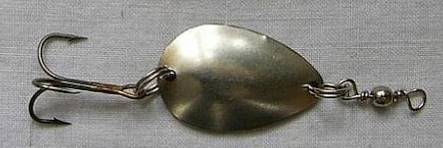
DIY trout spoon
The easiest way is to make a “oscillator”. Making the “rotator” is harder and more complex.
What materials to make it from?
The handle of a stainless spoon with drilled holes on both ends is a good spoon for catching any fish. For trout spoons you will have to think and work a little.
You will need:
- Sheet copper 1 mm thick.
- Metal scissors.
- Hammer.
- File and sandpaper.
Using metal scissors, we cut out a “vibration” shape from a sheet of copper, 35 mm long and 12 mm wide at the head. Weight about 2.2-2.5 g.
We take a hammer and with a few blows we make a spinner out of this blank, similar to a factory one. We punch or drill holes at the ends and clean them with sandpaper.
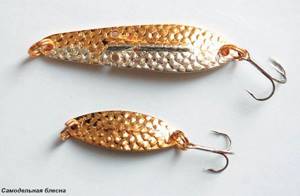
Now we check her game in a container of water. The frequency is measured by the bending angle of the entire spoon. We put a ring on one side and a hook on the other. You can tune this lure - attach several red threads to the hook, it will become more noticeable to the fish.
It is more difficult to make a spinner spoon for trout fishing with your own hands. You will need a tool and some skills to work with it. The fish should have no doubt that this is not a living fry.
To work you will need:
- Brass or copper petal.
- Beads of different colors.
- Polymer tubes.
- Clamps, threads.
- Steel wire with a diameter of at least 0.5 mm.
The cut petal is fixed on the axis with a clamp, beads and a polymer tube are put on the axis. The end of the wire rod is twisted into a ring to secure the hook. The rotation of the petal itself depends on the quality of the clamp. Make all the parts in advance from copper blanks - this will give the “pinwheel” a golden color.
How to make a homemade vibrator
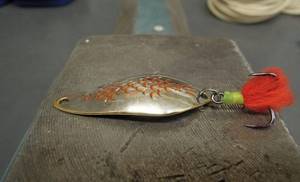
The production of an oscillating spinner can be divided into two techniques, which are convenient to use when designing and manufacturing a future product. For the first method, you should modify any factory-made item that is similar in shape and size to a purchased bait. One of these items is a tablespoon in its various modifications, from tea spoon to sauce spoon, provided that it is made of metal. Both the spoon itself and its handle will go into production.
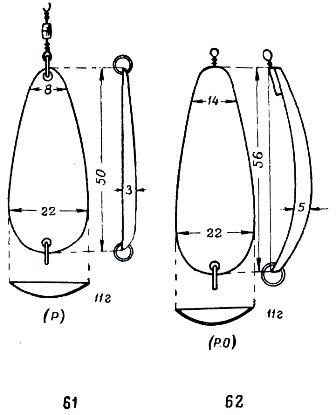
The handle is quite suitable for constructing a vertical spinner, and the spoon itself is the finished body of the spinner. To upgrade it to a full-fledged fishing lure, you will need to drill holes in the tops of the ovals and equip them with winding rings. One ring is supplemented with a swivel, and a tee is mounted in the second. When testing on water, the performance of the product is adjusted by increasing or decreasing the convexity of the shape. This is done by lightly tapping a wooden mallet on one side of the spoon, placing it on a hard surface.
Important! With increased convexity, the game becomes more lively and shallow. By reducing the deflection, the game is made sweeping and calmer.
Using the second method, do-it-yourself spinners are made from sheet metal or its alloys. For these purposes, stainless steel, copper or brass plates are used. This material can be quite easily mechanically cut and then minted to give the product the desired shape. A plate thickness of 0.5-2 mm is exactly what is needed for production.
Initially, the shape of the future fishing bait is marked on the sheet, taking into account allowances for bends and deformations for convexities. Having cut out the workpiece, the edges of the metal are processed and holes are drilled according to the first type of production for the swivel and tee. Next, concavities or bends of the edges are minted. After giving the final shape, the product is polished to a soft shine and tested.
Having adjusted the game to the required conditions by folding, additional embossing and loading, which is carried out using soldering or riveting methods, the product is brought into its final form, adding colors if necessary, retrofitting with additional fish-attracting accessories and engraving.
With a responsible approach to the production of the product, a home-made spinner will be in no way inferior in appearance to a purchased copy, and with scrupulous debugging of the game, homemade spoons are more catchy and much easier to control when performing postings.


